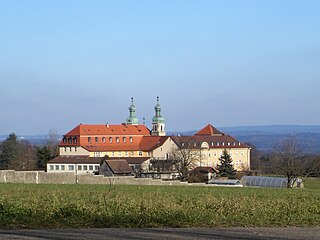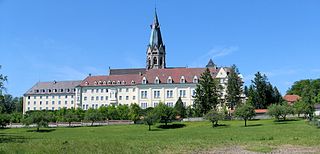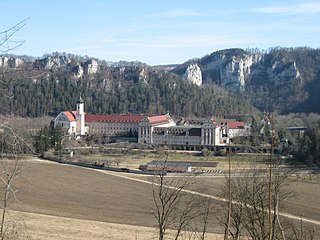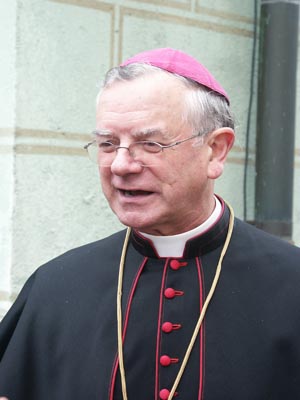
Beuron Archabbey is a major house of the Benedictine Order located at Beuron in the upper Danube valley in Baden-Württemberg in Germany.

Gerleve Abbey is a monastery of the Benedictine Order situated between Coesfeld and Billerbeck in Westphalia, in Germany.

Nütschau Priory is a house of the Benedictine Order located at Travenbrück near Bad Oldesloe, Stormarn, Schleswig-Holstein in Germany.

Seckau Abbey is a Benedictine monastery and Co-Cathedral in Seckau in Styria, Austria.

Weingarten Abbey or St. Martin's Abbey is a Benedictine monastery on the Martinsberg in Weingarten near Ravensburg in Baden-Württemberg (Germany).

St. Erentraud's Abbey, Kellenried, otherwise Kellenried Abbey, is a Benedictine nunnery in Kellenried. The abbey belongs to the town of Berg in Baden-Württemberg, Germany.

Maredsous Abbey is a Benedictine monastery at Maredsous, in the municipality of Anhée, Wallonia, Belgium. It is a founding member of the Annunciation Congregation of the Benedictine Confederation.

Gerard van Caloen (1853–1932) was a Belgian Benedictine liturgist, missionary, monastic founder, abbot, and bishop. He was rector of the abbey school at Maredsous, where in 1882 he published the Missel des Fidèles, the first French-Latin missal. He also introduced British-style association football to the school. In 1886, he was professor of liturgy at the College of Sant'Anselmo in Rome.

St. Ottilien Archabbey is a Benedictine monastery in Emming near Eresing and the Ammersee in the district of Landsberg, Oberbayern, Germany. It is the motherhouse of the St. Ottilien Congregation.

The Ottilien Congregation, often also known as the St. Ottilien Congregation and as the Missionary Benedictines, is a congregation of religious houses within the Benedictine Confederation, the aim of which is to combine the Benedictine way of life with activity in the mission field.

The Beuron art school was founded by a confederation of Benedictine monks in Germany in the late 19th century.

St. Matthias' Abbey is a Benedictine monastery in Trier, Rhineland-Palatinate, Germany.

Andreas Amrhein was a Swiss Benedictine monk who founded the Benedictine Congregation of Saint Ottilien and the Missionary Benedictine Sisters of Tutzing to combine the Benedictine way of life with activity in the mission field.

Maurus Wolter was the first abbot of the Benedictine Beuron Archabbey, which he founded with his brother Placidus in 1863.

The Congregation of the Annunciation, formerly known as the Belgian Congregation, is a congregation of monasteries within the Roman Catholic Benedictine Confederation. Founded in 1920, the Congregation includes fifteen independent male monasteries spread throughout ten countries. Additionally, two female monasteries are members of the Congregation, while a further ten are affiliated with the Congregation.

Viktor Josef Dammertz was a German Benedictine monk of St. Ottilien Archabbey located in Bavaria, Germany, which is part of the Benedictine Congregation of Saint Ottilien. He was elected and served as the sixth Abbot Primate of the Benedictine Confederation of the Order of Saint Benedict from 1977-1992. He was nominated by Pope John Paul II as Bishop of the Diocese of Augsburg 24 December 1992, consecrated 30 January 1993, and resigned 9 June 2004.
Albert Schmidt OSB is a German Benedictine monk and presiding abbot of the Beuronese Congregation, an association of eighteen mostly German or German-speaking Benedictine monasteries and convents, headed by Beuron Abbey in the upper Danube Valley. This makes him the Congregation's highest ranking dignitary and a High Superior in church law terms.

Hildebrand de Hemptinne was a Belgium Benedictine monk of Beuron Archabbey, the second Abbot of Maredsous Abbey, and the first Abbot Primate of the Order of St. Benedict and the Benedictine Confederation.

The College of Sant'Anselmo is an international Benedictine college founded by Pope Leo XIII in 1887 and located in Rome, Italy. Situated on the Aventine Hill, it is one of four Benedictine institutions that occupy the complex known as "Sant'Anselmo all'Aventino" which serves as the Primatial Abbey of the Benedictine Confederation. As an ecclesiastical residential college in the Roman College tradition, it serves as both a house of formation for Benedictines, but also as a residence for over one hundred monks from around forty countries, religious, diocesan priests, and lay people. It offers a monastic environment for those who study at the onsite Pontifical Athenaeum of Saint Anselm or at other Roman pontifical universities.

Fidelis von Stotzingen was a German Benedictine monk of Beuron Archabbey, the second Abbot of Maria Laach Abbey, and the second Abbot Primate of the Order of St. Benedict and the Benedictine Confederation.




























